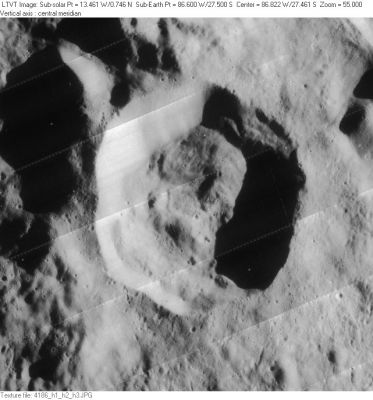Pettit
Contents
[hide]Pettit (of the pair Nicholson-Pettit)
|
Lat: 27.5°S, Long: 86.6°W, Diam: 35 km, Depth: 3.91 km, [/R%C3%BCkl%2050 Rükl 50], [/Stratigraphy Eratosthenian] |
Table of Contents
[#Pettit (of the pair Nicholson-Pettit) Pettit (of the pair Nicholson-Pettit)]
[#Pettit (of the pair Nicholson-Pettit)-Images Images]
[#Pettit (of the pair Nicholson-Pettit)-Maps Maps]
[#Pettit (of the pair Nicholson-Pettit)-Description Description]
[#Pettit (of the pair Nicholson-Pettit)-Description: Wikipedia Description: Wikipedia]
[#Pettit (of the pair Nicholson-Pettit)-Additional Information Additional Information]
[#Pettit (of the pair Nicholson-Pettit)-Pettit and Nicholson Pettit and Nicholson]
[#Pettit (of the pair Nicholson-Pettit)-Nomenclature Nomenclature]
[#Pettit (of the pair Nicholson-Pettit)-LPOD Articles LPOD Articles]
[#Pettit (of the pair Nicholson-Pettit)-Bibliography Bibliography]

LO-IV-186H
Images
LPOD Photo Gallery Lunar Orbiter Images
Maps
([/LAC%20zone LAC zone] 91D1) USGS Digital Atlas PDF
Description
Description: Wikipedia
Additional Information
- Depth data from [/Kurt%20Fisher%20crater%20depths Kurt Fisher database]
Westfall, 2000: 3.91 km - TSI = 20, CPI = 5, FI = 15; MI =40 [/Smith%20and%20Sanchez%2C%201973 Smith and Sanchez, 1973]
Pettit and Nicholson
Here's the reason why a "twin"-couple of pronounced craters in Mare Orientale's Rook Mountains were called Pettit and Nicholson:
- In the early 1920s, Edison Pettit and Seth Nicholson made the first systematic infrared observations of celestial objects. They used a vacuum thermocouple to measure the infrared radiation and thus the temperature of the Moon which led to the theory that the Moon was covered with a thin layer of dust acting as an insulator, and also of the planets, sunspots and stars. Their temperatures measurements of nearby giant stars led to some of the first determinations of stellar diameters.
Nomenclature
- Edison Pettit (1889-1962); American astronomer active at Mount Wilson Observatory. Pettit had wide-ranging interests, and in lunar work was noted for his studies of the variation of temperatures on the lunar surface, particularly during eclipses. [/Wilkins%20and%20Moore Wilkins and Moore] also attribute a relief map of the Moon, constructed at Mount Wilson in 1930, to Pettit (their Appendix II).
- This crater is not to be confused, thank you, IAU, with [/Petit Petit]
LPOD Articles
Bibliography
- Nicholson, Seth B. Edison Pettit, 1889-1962 Publications of the Astronomical Society of the Pacific, Vol. 74, No. 441, p.495. (1962) (Note: the crater [/Nicholson Nicholson] lies next to Pettit on the Moon.
- Pettit, Edison. The Co-Albedo of the Moon. Astrophysical Journal, vol. 102, p.14 (1945)
- Pettit, Edison. Radiation Measurements on the Eclipsed Moon. Astrophysical Journal, vol. 91, p.408 (1940)
- Pettit, E.; Nicholson, S. B. Lunar radiation and temperatures Astrophys. J., vol. 71, p. 102-135 (1930).
- Pettit, E.; Nicholson, S. B. Temperature of the Dark Side of the Moon and of the Moon During Eclipse Publications of the Astronomical Society of the Pacific, Vol. 39, No. 230, p.227 (1927)
This page has been edited 1 times. The last modification was made by - tychocrater tychocrater on Jun 13, 2009 3:24 pm - afx3u2